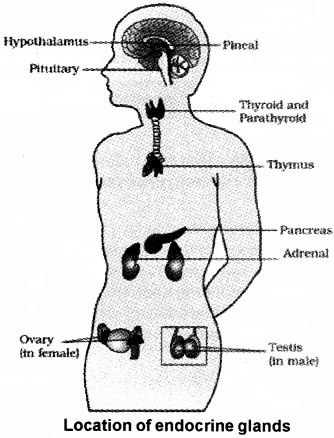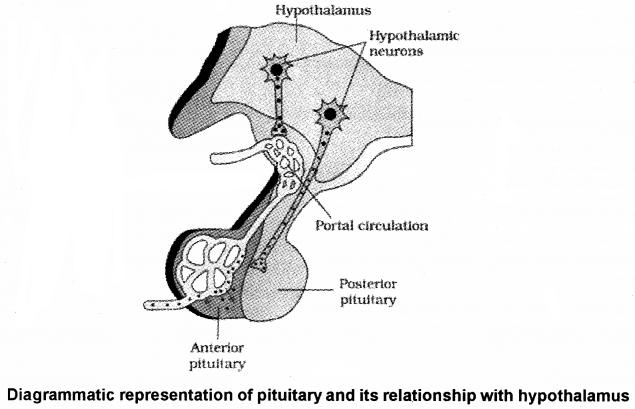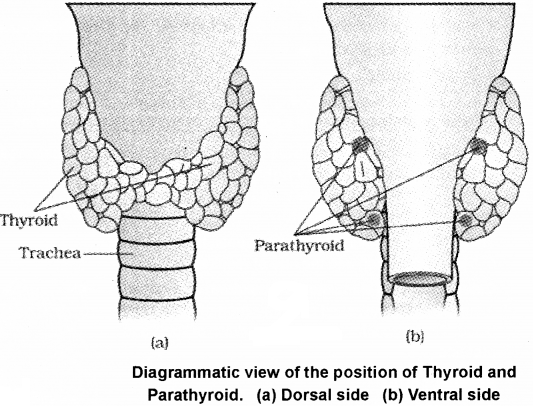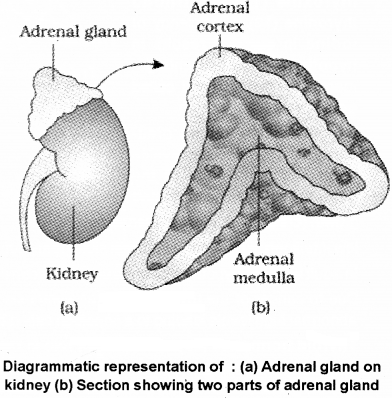Kerala Plus One Zoology Notes Chapter 11 Chemical Coordination and Integration
What is the neural system?
The neural system and the endocrine system coordinate and regulate the physiological functions in the body.
Endocrine Glands And Hormones:
Endocrine glands lack ducts and are called ductless glands. Their secretions are called hormones.
| Hormones are non-nutrient chemicals which act as intercellular messengers and are produced in trace amounts |
Human Endocrine System
The endocrine glands are located in different parts of our body constitute the endocrine system. Pituitary, pineal, thyroid, adrenal, pancreas, parathyroid, thymus and gonads (testis in males and ovary in females) are the organised endocrine bodies in our body.
In addition to these, some other organs, eg: gastrointestinal tract, liver, kidney, heart also produce hormones.

The Hypothalamus:
The hypothalamus is the basal part of diencephalon, forebrain and it regulates body functions. The hormones produced by hypothalamus are of two types
- The releasing hormones (which stimulate secretion of pituitary hormones)
- The inhibiting hormones (which inhibit secretions of pituitary hormones).
For example,
| Hypothalamic hormone called Gonadotrophin releasing hormone (GnRH) stimulates the pituitary synthesis and release of gonadotrophins. |
| Somatostatin from the hypothalamus inhibits the release of growth hormone from the pituitary. |
These hormones originating in the hypothlamic neurons, pass through axons and are released from their nerve endings reach the pituitary gland through a portal circulatory system and regulate the functions of the anterior pituitary. The posterior pituitary is under the direct neural regulation of the hypothalamus.

The Pituitary Gland:
The pituitary gland is located in a bony cavity called sella tursica. It is divided into an adenohypophysis and a neurohypophysis.
Adenohypophysis:
It consists of two portions, pars distalis and pars intermedia. The pars distalis region of pituitary, commonly called anterior pituitary, produces growth hormone (GH), prolactin (PRL), thyroid-stimulating hormone (TSH), adrenocorticotrophic hormone (ACTH), luteinizing hormone (LH) and follicle-stimulating hormone (FSH).
Pars intermedia secretes only one hormone called melanocyte stimulating hormone (MSH). Pars intermedia is almost merged with pars distalis.
Neurohvpophysis:
It is also known as posterior pituitary, stores and releases two hormones called
- Oxytocin
- vasopressin
Function:
These are synthesised by the hypothalamus and are transported to neurohypophysis.
Growth hormone:
Over-secretion of GH stimulates abnormal growth of the body leading to gigantism and low secretion of GH results in stunted growth resulting in pituitary dwarfism. Prolactin regulates the growth of the mammary glands and formation of milk in them.
TSH stimulates the synthesis arid secretion of thyroid hormones from the thyroid gland. ACTH stimulates the synthesis and secretion of steroid hormones called glucocorticoids from the adrenal cortex. LH and FSH stimulate gonadal activity and called as gonadotrophins.
Activity of LH and FSH in males and females:
In males, LH stimulates the synthesis and secretion of hormones called androgens from testis. In males, FSH and androgens regulate spermatogenesis. In females, LH induces ovulation of fully mature follicles (graafian follicles) and maintains the corpus luteum, formed from the graafian follicles after ovulation.
In females FSH stimulates growth and development of the ovarian follicles. MSH acts on the melanocytes (melanin containing cells) and regulates pigmentation of the skin. Oxytocin stimulates a vigorous contraction of uterus at the time of child birth, and milk ejection from the mammary gland.
Hormone in water reabsorption:
Vasopressin acts on kidney and stimulates resorption of water and electrolytes by the distal tubules and thereby reduces loss of water through urine (diuresis). Hence, it is also called as anti-diuretic hormone (ADH).
The Pineal Gland:
The pineal gland is located on the dorsal side of forebrain. It secretes a hormone called melatonin. It regulates 24-hour (diurnal) rhythm of our body. For example, it helps in maintaining sleep-wake cycle, body temperature, metabolism, pigmentation, the menstrual cycle as well as our defense capability.
Thyroid Gland:
It is composed of two lobes which are located on either side of the trachea. The thyroid gland is composed of follicles and stromal tissues. The follicular cells synthesise two hormones, tetraiodothyronine or thyroxine (T4) and triiodothyronine (T3). Deficiency of iodine in our diet results in hypothyroidism and enlargement of the thyroid gland called goitre.
Hypothyroidism during pregnancy causes defective development and maturation of the growing baby leading to stunted growth (cretinism), mental retardation, low intelligence quotient, abnormal skin, deaf-mutism, etc.
In adult women, hypothyroidism cause the occurrence of irregular menstrual cycle. Due to cancer of the thyroid gland the synthesis and secretion of the thyroid hormones is increased to abnormal high levels leading to a condition called hyperthyroidism.

Parathyroid Gland:
It is present on the back side of the thyroid gland and secrete a peptide hormone called parathyroid hormone (PTH).
| Parathyroid hormone (PTH) increases the Ca2+ levels in the blood. It acts on bones and stimulates the process of bone resorption (dissolution/demineralisation). |
PTH also stimulates reabsorption of Ca2+ by the renal tubules and increases Ca2+ absorption from the digested food. Hence PTH is a hypercalcemic hormone i.e., it increases the blood Ca2+ levels. Along with TCT, it plays a significant role in calcium balance in the body.
Thymus:
The thymus gland is located on the dorsal side of the heart and the aorta and plays a major role in the development of the immune system.
| This gland secretes the peptide hormones called thymosins which is involved in the differentiation of T-lymphocytes and provides cell-mediated immunity. |
| Thymosins also promote production of antibodies to provide humoral immunity. Thymus is degenerated in old individuals and the immune responses of old persons become weak. |
Adrenal Gland:
It is located at the anterior part of each kidney. The gland is composed of inner adrenal medulla, and outside the adrenal cortex.
Adrenal medulla:
| It secretes two hormones called adrenaline or epinephrine and noradrenaline or norepinephrine. These are commonly called as catecholamines |
Adrenaline and noradrenaline are secreted during emergency situations and are called emergency hormones or hormones of Fight or Flight. These hormones increase alertness, pupilary dilation, piloerection (raising of hairs), sweating, etc.
These hormones increase the heart beat, the strength of heart contraction and the rate of respiration. Catecholamines stimulate the breakdown of glycogen resulting in an increased concentration of glucose in blood. They also stimulate the breakdown of lipids and proteins.
Adrenal cortex:
It is divided into three layers, called
- zona reticularis (inner layer)
- zonafasciculata (middle layer)
- zona glomerulosa (outer layer).
The secretory hormones are commonly called as corticoids. They are involved in carbohydrate metabolism called as glucocorticoids. eg: Cortisol.

Function:
It maintains the cardiovascular system as well as the kidney functions, suppresses the immune response and stimulates RBC production. Corticoids, which regulate the balance of water and electrolytes in our body are called mineralocorticoids. eg: Aldosterone.
Glucocorticoids stimulate, gluconeogenesis, lipolysis and proteolysis and inhibit cellular uptake and utilisation of amino acids. Aldosterone stimulates the reabsorption of Na+ and water and excretion of K+ and phosphate ions.
Hence it helps in the maintenance of electrolytes, body fluid volume, osmotic pressure and blood pressure. Androgenic steroids secreted by the adrenal cortex which play a role in the growth of axial hair, pubic hair and facial hair during puberty.
Pancreas:
It acts as both exocrine and endocrine gland. The endocrine consists of ‘Islets of Langerhans’.
| The two main types of cells in the Islet of Langerhans are called alpha cells and beta -cells. The alpha cells secrete a hormone called glucagon, while the beta cells secrete insulin |
Glucagon is a peptide hormone that maintains normal blood glucose levels, stimulates glycogenolysis – increased blood sugar (hyperglycemia), stimulates the process of gluconeogenesis – contributes to hyperglycemia. Insulin is a peptide hormone, which enhances cellular glucose uptake and utilisation.
As a result, there is a rapid movement of glucose from the blood to hepatocytes and adipocytes resulting in decreased blood glucose levels (hypoglycemia). Insulin also stimulates conversion of glucose to glycogen (glycogenesis) in the target cells.
Prolonged hyperglycemia leads to a complex disorder called diabetes mellitus which is associated with loss of glucose through urine and formation of harmful compounds known as ketone bodies.
Testis:
A pair of testis is present in the scrotal sac of male individuals Testis performs dual functions as a primary sex organ as well as an endocrine gland. Testis is composed of seminiferous tubules and stromal or interstitial tissue. The Leydig cells or interstitial cells, which produce a group of hormones called androgens mainly testosterone.
Androgens regulate the development, maturation and functions of the male accessory sex organs like epididymis, vas deferens, seminal vesicles, prostate gland, urethra etc.
Androgens also stimulate muscular growth, growth of facial and axillary hair, aggressiveness, low pitch of voice, spermatogenesis (formation of spermatozoa), influence the male sexual behaviour (libido).
These hormones produce anabolic (synthetic) effects on protein and carbohydrate metabolism.
Ovary:
It is the primary female sex organ which produces one ovum during each menstrual cycle. Ovary produces two groups of steroid hormones called estrogen and progesterone. The estrogen is are secreted by the growing ovarian follicles. After ovulation, the ruptured follicle is converted to a structure called corpus luteum, which secretes progesterone.
Estrogens involved in stimulation of growth and activities of female secondary sex organs, development of growing ovarian follicles, appearance of female secondary sex characters (e.g., high pitch of voice, etc.), mammary gland development, regulate female sexual behaviour.
Progesterone supports pregnancy, stimulates the formation of alveoli (sac-like structures which store milk) and milk secretion.
Hormones Of Heart Kidney And Gastrointestinal Tract:
The atrial wall of our heart secretes a very important peptide hormone called atrial natriuretic factor (ANF), which decreases blood pressure. When blood pressure is increased, ANF is secreted which causes dilation of the blood vessels. This reduces the blood pressure.
The juxtaglomerular cells of kidney produce a peptide hormone called erythropoietin which stimulates erythropoiesis (formation of RBC). The gastro-intestinal tract secrete four major peptide hormones, namely gastrin, secretin, cholecystokinin (CCK) and gastric inhibitory peptide (GIP).
Gastrin stimulates the secretion of hydrochloric acid and pepsinogen. Secretin stimulates secretion of water and bicarbonate ions. CCK acts on both pancreas and gall bladder and stimulates the secretion of pancreatic enzymes and bile juice, respectively. GIP inhibits gastric secretion and motility.
Mechanism Of Hormone Action:
Hormones bind to specific proteins called hormone receptors Hormone receptors present on the cell membrane of the target cells are called membrane-bound receptors and the receptors present inside the target cell are called intracellular receptors.
Binding of a hormone to its receptor leads to the formation of a hormone-receptor complex. Hormone- Receptor complex formation leads to certain biochemical changes in the target tissue. On the basis of their chemical nature, hormones can be divided into groups.
- peptide,
- polypeptide,
- protein hormones (eg: insulin, glucagon, pituitary hormones, hypothalamic hormones, etc.)
- steroids (eg: cortisol, testosterone, estradiol and progesterone)
- iodothyronines (thyroid hormones)
- amino-acid derivatives (eg: epinephrine).
Hormones which interact with membrane-bound receptors do not enter the target cell, but generate second messengers (eg: cyclic AMP, IP3, Ca++, etc) which in turn regulate cellular metabolism. Hormones which interact with intracellular receptors (eg: steroid hormones, iodothyronines, etc.) regulate gene expression or chromosome function.


Exophthalmic goitre, also called Grave’s disease:
This occurs due to hyperthyroidism i.e the excessive secretion of thyroxine hormone is accompanied by the enlargement of the thyroid glands. It is an autoimmune disease where patients produce antibodies that act on the thyroid glands to increase thyroxine hormone production and thyroid size. eg: Patients suffering from cancerof thyroid glands.
The symptoms are elevated metabolic rate, sweating, rapid and irregular heartbeat, weight loss despite increased appetite, frequent bowel movement and nervousness. Some patients may also experience exophthalmos (or protrusion of the eyeballs). Thus this condition is also known as exophthalmic goitre.
Addison’s’ disease:
The hyposecretory disorder of the adrenal cortex or destruction of adrenal cortex in diseases such as tuberculosis leads to deficit of both glucocorticoids and mineralocorticoids. This condition is known as Addison’s disease. The symptoms are loose weight, their blood glucose and sodium levels drop and potassium levels rise.
NCERT SUPPLEMENTARY SYLLABUS
Exophthalmic goitre, also called Grave’s disease:
This occurs due to hyperthyroidism i.e the excessive secretion of thyroxine hormone is accompanied by the enlargement of the thyroid glands.
It is an autoimmune disease where patients produce antibodies that act on the thyroid glands to increase thyroxine hormone production and thyroid size. eg: Patients suffering from cancer of thyroid glands.
The symptoms are elevated metabolic rate, sweating, rapid and irregular heartbeat, weight loss despite increased appetite, frequent bowel movement and nervousness. Some patients may also experience exophthalmos (or protrusion of the eye balls). This condition is also known as exophthalmic goitre.
Addison’s’ disease:
The hyposecretory disorder of the adrenal cortex or destruction of adrenal cortex in diseases such as tuberculosis leads to deficit of both glucocorticoids and mineralocorticoids.
This condition is known as Addison’s disease. The symptoms are weight loss, blood glucose and sodium levels drop and potassium levels rise.
